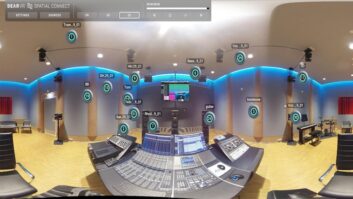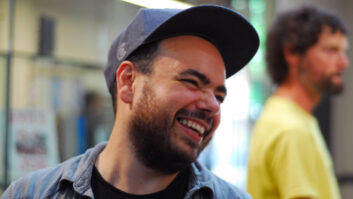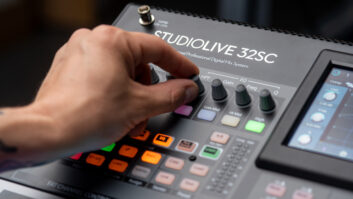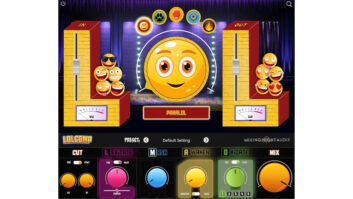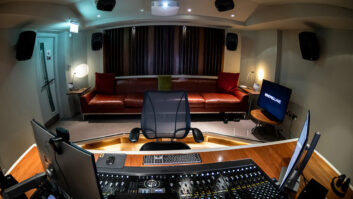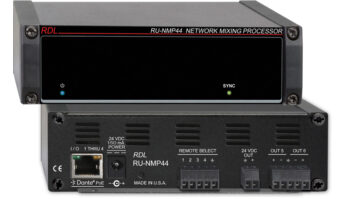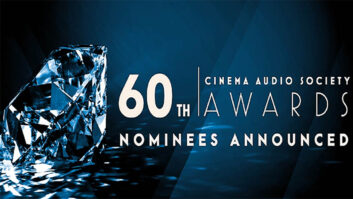Twenty-eight-year-old engineer/mixer/producer Andy Bradfield is one of the new breed of British engineers-a busy independent who has his hands full doing an amazingly broad range of projects, from big band jazz to pop to dance tracks of every variety. His extensive credit list shows both established and up-and-coming acts, including the Spice Girls, Honeyz, Everything But the Girl, Pet Shop Boys, Maxi Priest, Catch, Neneh Cherry, Gary Moore, Kylie Minogue, Future Sound of London, Bjork, The Chieftains, the Charlie Watts Quintet, Lamont Dozier and Julia Fordham. We caught up with the affable and energetic Bradfield last spring when he came to the U.S. for the Grammy Awards.
So you were nominated for a Grammy for working on Robbie Robertson’s album, Contact From the Underworld of Redboy?
Yes, for Best Engineered Album. Howie B. had done quite a lot of the record, and he’d mixed about half of it, some of it in L.A., and then he got tied up with U2 and was on tour with them and couldn’t finish the record. He suggested that Marius de Vries get involved and that’s who I ended up working with. Basically I ended up mixing almost half the record at Townhouse in London with Marius. The Grammy nomination came totally out of the blue. I’d done the work so long ago it was a real surprise to get the nomination. I was completely amazed and flattered as well.
How did you get into this business?
When I was about 13 or 14 I used to go around recording everything known to man. I grew up in Essex, and I had a little tape recorder and a microphone. We’re talking mid to late ’80s. My mom and dad saw that I was interested in this and allowed me to pursue it, which was great. I took this paid course where I went to a little studio, and though it didn’t teach me bucketloads about how I do my job now, it definitely got me hooked. The studio was called Diploma, and it was very well-run, and it totally hooked me. It was a 20-week course, one night a week, from about 6 till midnight.
By the time I was 16, I was pretty well hooked, and I was working an afternoon a week, which usually stretched into the evening, of course, and my friends were all asking, “Are you sure you want to do this? The money’s no good, and it’s crap hours, and you’ll be making tea and starting at the bottom…”
The infamous “tea boy” role of British story and song!
Exactly! The infamous tea boy! And I said, “Yeah, this is what I want to do.” Because I thought I’d found something: “Yeah, this is me. This is my niche.” I was working at this little studio, and the owner would say, “You know, you really should go into town [London] if you’re serious about this.” So I sent out about 60 letters to studios and heard back from four or five. I ended up in this program called YTS-Youth Training Scheme-but you might as well have called it slave labor. The bottom line is they pay you absolutely horrific money and you work quite hard. I went to a studio called Red Bus in London for about six months, but The Townhouse had also said, “We’ll keep you on file.” Five months later-this is September 1987-The Townhouse wrote me and said, “We’re opening a new facility called Olympic Studios, and will you come in for an interview?” They offered me a job, and when I told the people at Red Bus they were amazed. To be honest, I didn’t know much about Townhouse, so I was asking the people at Red Bus, “Is Townhouse good, then?” [Laughs.]
So I really landed on my feet. But it was tough work-they work you very, very hard. But it was immediately clear to me that this was a good place to be.
And was it a tea boy position, logging tapes, etc.?
Absolutely. Although I didn’t have to log tapes or align machines, which was done by the maintenance people. That varies from studio to studio in London. Almost straight away they put me to being an assistant.
That’s mic setups and cabling and breaking down sessions…
Right, the whole deal. You’re the engineer’s assistant-though you do also make the tea for the session, as well. Doing all that was a tremendous education. I got to be part of some great sessions.
What was the first session you did where you thought, “Yeah, this is why I got into this business-to be part of this”?
It was a Joe Jackson mixing session at Olympic. I was a bit of fan: “Wow. Joe Jackson! This is fantastic.” He was doing final overdubs and mixing. I was mostly just making sure the right tapes are up and available, making sure that all the slave machines are hooked up, any kind of synchronization that needs to be done, so that when the engineer walks in and hits Play, the session is up and running.
From there, I started getting more and more opportunities to do things. Once you look like you know what you’re doing, engineers-particularly the kind who are engineer/producers-are happy to hand off some duties to you. It’s very difficult being both an engineer and producer on a session, so they need help. This ended up being a great way to learn. So I found myself in situations where I’d semi be in charge of the engineering, but at the same time you still have someone to fall back on if you don’t know how to do something.
I worked with some brilliant people on the way up: I used to assist a lot for Mark “Spike” Stent and wound up engineering for him, which was great but hard, because he’s a phenomenal engineer himself. I also did quite a lot of work with Bob Clearmountain. He was great to work with because he’s a very good teacher; he’s very patient. But also, if he sees you have an aptitude for something as an assistant, he’ll push you. Another one was Robin Miller, who doesn’t engineer but has got an amazing pair of ears, and he’s great at describing things. So those people were all influential on me.
How did you gravitate to mixing?
It was just one of those things that I really enjoyed. It wasn’t really a conscious decision, but I found myself doing lots of mixing and enjoying it. Then I went in and did a couple of long recording sessions, and I thought, “Oh man, we’re on the eighth day of doing vocals. What a drag!” What I like about mixing is you get a high turnover of work in a short space of time. You get a lot of satisfaction because you’re finishing things, or attempting to finish things. I like the part of feeling slightly under the gun: “You have to mix these four tracks by the end of the week,” or whatever the schedule is. You’re working toward a specific end point.
Do you have any specific aim in mind, sonically, when mixing a typical project?
Not really. You’re just aiming to make anything you work on sound good-including the songs that are really terrible! [Laughs.] And to sound good on any system. I’ll walk into a shop and hear a song I worked on playing out of this awful little mono speaker, and after the intital shock wears off, I think, “Hey that still sounds pretty good!” I was taught from early on to make sure you listen in mono and on a variety of different speakers.
Do you carry your own reference monitors?
I do. I’m actually very fussy about what I work on. I’ve got a Bryston 3B amp, for which I’ve had a switcher box made so I can have three sets of small monitors. I have one set of Auratones, a pair of NS-10s and a pair of KRK 9000Bs, which I wouldn’t be without; I love them dearly. I move around quite a lot-although I also do a fair amount at Townhouse and Olympic. I work at AIR, at SARM, all over. They’re all pretty good rooms. But the KRKs give me the bottom end I need wherever I go. Monitoring is such a personal thing, and when I started moving around a lot, that’s when I realized how important it is.
You’re an SSL man?
Almost exclusively. I like the SSL G Series the best, even more than the 9000, which is a little clean-sounding for my taste, believe it or not, although I do mix some things on it now that I’ve learned how to use the automation. It’s a great tracking console. But I love the G Series EQs. I get tapes in all sorts of states, shall we say. Sometimes they’re not bad, sometimes they’re horrible. Sometimes they’re brilliant. It just depends. But I find I can sort things out best on the G Series.
Any favorite pieces of gear at the moment?
One of my favorite boxes at the moment is TC Fireworx. It’s completely mad, that’s what I like about it. It’s not your run-of-the-mill reverb. I have a few bits and pieces I carry around, but they’re mostly unusual things you don’t find in studios. I’ve got an LA-3A, which is a fantastic vocal processor you find more in the U.S. than in England. I’ve also got an Avalon VT737 compressor/EQ, and I tend to record a lot through that. I do a lot of tracking to Pro Tools, and sometimes if you’re in the middle of a mix and you need to do a quick overdub, rather than messing about and changing the desk and risk double-routing things when you’re using the groups to send effects, I’ll just put the mic straight into the Avalon into the back of the tape machine, and it’s easier. I also have an Apogee AD800, which I use for going into Pro Tools, as the “soft limit” is fantastic for keeping those nasty peaks under control. And it sounds great.
To what degree are you influenced to take a mixing assignment by who engineered it?
Not much. I’ll try to give something a listen to determine whether there’s anything I can do with it. Unless it’s something I absolutely detest, and there aren’t many things of that ilk. But I’m not going to take something I don’t like just because of the money. That’s not fair to the project, and at the end of the day, those are the ones that end up being a nightmare for some reason-maybe because you’re not committed. Sometimes you’ll do something you don’t like as a favor to someone, and they always end up being the most difficult jobs! [Laughs.]
When you get a multitrack, say a 48, of a song, what’s the first thing you do?
The first thing I do is shove up all the faders and have a listen. I’ll usually have a DAT or a CD-R of the rough mix or original mix or whatever it is. I’ll usually have spoken to the record company and the producer and artist, and they’ll have told me what they want.
What’s the range of things they’ll want?
It varies. How I started to get into producing is that record companies would send me tapes and ask my opinion and I’d say, “It’s nice, but I think I’d put this section here and do this to that part and bring in that other part later…” And they’d say, “Well, do you want to sort it out, then?” And suddenly they were authorizing me bringing in backup singers and having three days instead of a day.
Is there any one problem you can generalize about the state of the tapes you get?
Well, I think a lot of people are over-recording. They put too much on every song; there’s too much on tape. So one of the things I often end up doing is taking things out. I’ll come in and look at the tapes: “Oh my God! Two analog 24-tracks and a RADAR! Oh, no!” And you put about five faders up, and it’s like, “Help! I can’t hear anything!” There are five drum loops going on and eight guitars. So then it becomes a trial-and-error situation: What if I take this bit out? I’ll listen to the rough mix and hear how things have moved forward or back in the mix as the song went on. If it’s what I call a kitchen sink production-you want it to sound big as a house-well, the more the merrier I suppose. But usually things can be eliminated. Sometimes people have put off decisions about things because they want the mixer to decide. And I’ve been guilty of that-when I can’t decide during the tracking which I like, I’ll put it off till the mix.
It’s that way with effects, too. Some things require bucketloads of effects; some almost none. It’s a taste thing, really. I think some engineers feel like they have to use everything in the room because it’s there. Why?
You did two tracks on the first Spice Girls album. How did that come about?
It was through Virgin, who I’d already done a lot with. When I got the tapes they hadn’t put out a record yet. There was a little buzz about them, but not much yet. I put the tapes on-“Two Become One” and “Love Thing.” They were good songs. It worked out well. They left me to my own devices pretty much, though I did have a lot of input from the record company. I’d send overnight mixes and get comments back. The girls had a few minor comments, which were fine. I went back and made all the changes in a day. Pow! Off it went.
You recorded and mixed the Charlie Watts Quintet. That was live in the studio, wasn’t it?
That was a total breeze. They were such nice people and such phenomenally talented musicians. It’s real old-school recording, and I like doing that now and again as a challenge because it really is, “Okay, go!” and then it’s down to me to get it on tape. We did it all analog, straight to tape. When we did the first record back in 1993, we did it all live-the five-piece band and 20 string players. It was quite a vibe. I really enjoyed it. It’s terrifying working that way, but it’s also really good.
Anyone new you’ve worked with recently we should be on the lookout for?
It’s funny because right now I’ve mostly been working with people who I’ve worked with before or who are established. Like I did an album with the Pet Shop Boys. I recorded eight tracks, half of them I mixed, half of them Spike Stent mixed. It’s a good record. Craig Armstrong produced, and it’s quite filmic. We did these huge orchestras up at AIR. An interesting project to do. Good fun.
I also did some mixing work on the new Everything But the Girl album up at AIR Studios in Hampstead. The album was tracked onto a RADAR II at 24 bits, which was good. I have also been at The Townhouse and recording and mixing a track for the new Tom Jones record with a big band in Studio 1. Tom’s been recording tracks for a while all over town, and the whole LP is duets with other artists, and what I’ve heard so far is great! The track we did was a duet with Cerys Mathews of Catatonia. The band consisted of 13 brass players, drums, bass, guitar, piano and Tom and Cerys all live. Wow, that was fun! Then, once we got the take, we had to reset the studio, and we dubbed 18 string players, so it was a fairly long, slightly chaotic day. But Tom and Cerys were fabulous and really good fun.
Then I went to Real World in Bath to mix tracks for Kelle Bryan. I love that part of England, as it’s very relaxed and also not too far away. So lots going on, which keeps me out of trouble!
Lansdowne Studios (London) completed a major refurbishment this past summer. Part of the renovations included the installation of a new custom 72-channel AMS Neve VX-S mixing console. The board is currently the largest VX-S in London and includes Flying Faders, Recall and an 8-channel surround sound film panel. Also installed were a new ATC surround monitoring system and Pro Tools|24. Lansdowne’s sister studio, CTS, has installed two Studer A827 24-track tape machines, bringing the studio total to four…M2-TV (London) purchased another Soundtracs digital console for its Camden facility. The desk is a 16-fader model with patchbay, capable of mixing 160 channels at 48k. Soundtracs also reports that a DPC-II was used for this summer’s Pavarotti and Friends concert in Parco Novi Sad in Modena, Italy. Proceeds from the event were used to aid needy children in Guatemala and Kosovo. In addition to the headliner, performing artists included B.B. King, Boyzone, Mariah Carey, Joe Cocker, Gloria Estefan and others…Concert Systems (Altrincham, Cheshire, UK) ordered two Midas Heritage 3000 consoles…The soon-to-be-completed Global Fusion Studios (Monterrey, Mexico) was designed by George Newburn of Studio 440; owner Francisco Lobo selected an SSL 9000J console…London-based Manor Mobiles, which recently celebrated its 25th anniversary, purchased an Axiom-MT digital console for one of its three trucks. Manor Mobiles is part of the studio group that includes Olympic Studios, Abbey Road and The Townhouse, where Rebecca Duncan has taken over duties as studio manager from Karen Harding…Recent projects undertaken by Toronto, Ontario’s LiveWire mobile include the Young Achievement Awards featuring a performance by B*Witched, Amanda Marshall on MuchMusic, The Moffatts performing for a future live album and a gospel festival featuring Salome Bey, Blaxam, the Youth Outreach Mass Choir and others…The Helsinki City Theatre purchased a Cadac J-Type console with 16×32 matrix. The board was supplied by Finish distributor Soundata Oy…London’s Rock Garden venue took delivery of a Spirit by Soundcraft Digital 328 console. Rock Garden has hosted performances by legendary artists including U2 and the Sex Pistols. A 328 is also being used on tour for pop group Cleopatra…Hideo Tanaka, longtime president of Hitokuchi-zaka Studios (Tokyo, Japan) retired recently. Sadatake Kikuchi was named the new president of the facility…Klark-Teknik reports that a KT DN3600 with remote and a DN60 analyzer were used during a Warner Classical tenth anniversary gala that took place at the Savoy hotel in London last June.
